Knowing how your customers behave is the difference between business success and failure in today’s data-driven marketing landscape. Companies that are good at personalization generate 40% more revenue than average players do.
But how do you do behavioral segmentation? In this all-inclusive guide, you will discover behavioral segmentation examples and learn how it could be your next step in transforming your marketing strategy. Whether you are just beginning to explore behavioral market segmentation or want to further build on an existing behavior, this article will help you gain a better perspective and hands-on practice of crafting more focused and effective marketing communications. Read on for real-world examples and some juicy strategies!
What is Behavioral Segmentation?
Behavioral segmentation is a rich marketing strategy through which customers are divided into groups based on their behavioral patterns, buying habits, and interaction with a brand. This approach to behavioral target markets goes beyond traditional demographic segmentation by focusing on how customers are differentiated on how they act rather than who they are.
The advancement in digital technology makes behavioral segmentation indispensable. Using advanced analytics helps track customer behavior over numerous touchpoints more precisely than ever.
When implementing behavioral segmentation, marketers analyze various data points, including:
- Purchase history and frequency
- Brand interactions across multiple channels
- Website browsing patterns
- Response to marketing campaigns
- Product usage behavior
- Customer service interactions
- Social media engagement
- Email interaction patterns
- Mobile app usage
- In-store behavior tracking
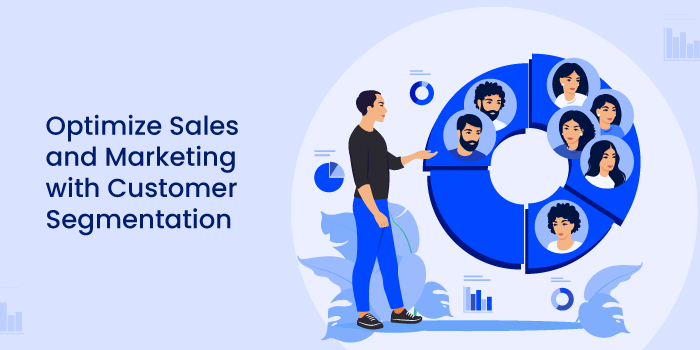
Behavioral segmentation is a type of market segmentation. The approach helps businesses gain a deeper understanding of customer behavior and preferences, enabling them to create highly targeted marketing campaigns. By focusing on how customers interact with a brand, rather than just who they are, businesses can identify the most engaged users and tailor their messaging to resonate more effectively.
The importance of behavioral segmentation cannot be overstated. It allows businesses to provide refined personalized experiences that cater to individual customer needs, ultimately building stronger brand loyalty. By understanding the nuances of customer behavior, companies can enhance their marketing strategies, ensuring that their efforts are both relevant and impactful. This improves customer satisfaction and fosters long-term relationships, making behavioral segmentation a crucial tool in modern marketing.
Benefits of Behavioral Segmentation
Enhanced marketing effectiveness
Companies can segment customer behaviors to be able to provide more relevant and engaging messaging. Leveraging comprehensive customer data is crucial for enhancing marketing strategies and improving the customer journey.
Success in this area requires:
- Consistent data collection across channels
- Regular analysis of behavioral patterns
- Dynamic content adaptation
- Real-time response capabilities
- Continuous testing and optimization
Improved resource allocation
Behavioral segmentation marketing examples imply that firms can allocate their marketing budgets more effectively by focusing on the most promising customer segments and channels.
Key benefits include:
- Reduced marketing waste
- Higher conversion rates
- Improved campaign performance
- Better targeting accuracy
- More efficient ad spend
Personalization of customer experience
Modern consumers need their experience tailored. Segmenting customers based on the ‘customer journey stage’ is crucial for effective personalization, as it allows businesses to deliver content and offers that facilitate progression through the sales funnel. Behavioral segmentation allows businesses to provide content, products, and services tailored to customers’ needs.
Effective personalization strategies include:
- Dynamic website content
- Personalized email campaigns
- Custom product recommendations
- Tailored promotional offers
- Individualized loyalty programs
- Adaptive mobile experiences
Pro tip: If you’d like to send out high-converting emails, you can use platforms like LeadSquared to find out which subject line has the highest open rates and what time works best for sending those emails. In this manner, you can determine which email is effective for a particular audience.
Increased customer retention rates
A 5% improvement in customer retention rates results in a 25% to 95% increase in profitability. Businesses may identify at-risk consumers and put focused retention measures in place by having a thorough understanding of customer behavior patterns.
Increased customer lifetime value
Behavioral segmentation plays a pivotal role in increasing customer lifetime value by enabling businesses to tailor their marketing efforts to specific customer groups. By understanding customer behavior and preferences, companies can create targeted marketing campaigns that resonate deeply with their audience. This personalized approach leads to increased customer loyalty and retention, as customers feel more understood and valued.
Moreover, behavioral segmentation helps businesses identify opportunities for upselling and cross-selling. By analyzing customer behavior, companies can pinpoint the right moments to introduce complementary products or services, thereby enhancing the overall customer experience and increasing the average transaction value. This strategic approach not only boosts immediate sales but also contributes to a higher customer lifetime value, making it a key component of a successful marketing strategy.
Types of Behavioral Segmentation
To help you better understand and meet your customers’ needs, we’ll discuss the different types of behavioral segmentation. Focusing on the right components or types of behavioral segmentation can give you actionable insights.
Purchasing behavior
When consumers choose to purchase goods or services, their decision-making processes and actions are referred to as purchasing behavior. Numerous factors, including individual preferences, societal influences, marketing tactics, and prevailing economic situations, all have an impact on this behavior. Your business can better fulfill customer wants by customizing your services and marketing initiatives according to these trends.
Purchase behavior includes factors such as:
- Purchase frequency and timing
- Average order value and patterns
- Product preferences and combinations
- Shopping cart abandonment patterns
- Payment method preferences
- Response to promotions and discounts
- Cross-category purchasing
- Brand loyalty indicators
- Price sensitivity metrics
- Seasonal buying patterns
Occasion-based segmentation
In 2024, Deloitte’s annual holiday retail estimate predicts that holiday retail sales would rise by 2.3% to 3.3%.
Customers often make purchases based on:
- Seasonal events (holidays, weather changes)
- Personal milestones (birthdays, anniversaries)
- Regular occasions (weekly grocery shopping)
- Special celebrations (weddings, graduations)
- Time-sensitive needs (emergency purchases)
- Cultural events and festivals
- Sports and entertainment events
- Business cycles
- Weather-related occasions
- Life stage transitions
Benefits sought
Understanding what customers value most helps in creating targeted offerings.
Based on what they seek, they can be categorized into:
- Quality conscious consumers
- Price-sensitive buyers
- Convenience seekers
- Status-oriented customers
- Innovation adopters
- Environmentally conscious shoppers
- Health-focused individuals
- Time-saving prioritizers
- Experience-focused customers
- Service-oriented buyers
Usage patterns
Analyzing how customers use products or services reveals important insights:
- Frequency of use
- Time of use
- Feature utilization
- Platform preferences
- Integration with other products
- Usage intensity
- Technical proficiency
- Customization preferences
- Social sharing behavior
- Problem-solving approaches
Loyalty-based segmentation
Loyalty-based segmentation is a powerful approach that categorizes customers based on their level of loyalty to a brand or product. This type of behavioral segmentation helps businesses identify their most loyal customers and develop strategies to retain them. By focusing on factors such as purchase frequency, purchase amount, and customer retention rate, companies can gain valuable insights into customer loyalty.
For instance, a business can create targeted marketing campaigns to reward and retain their most loyal customers. Offering loyalty rewards programs, exclusive discounts, or personalized offers can significantly boost customer satisfaction and loyalty. These strategies not only enhance the customer experience but also increase customer lifetime value. By recognizing and rewarding loyal customers, businesses can foster long-term relationships and drive sustained growth.
Customer journey stage segmentation
Customer journey stage segmentation categorizes customers based on their stage in the customer journey, which typically includes awareness, consideration, decision, and retention stages. By understanding where customers are in their journey, businesses can create targeted marketing campaigns to guide them through each stage, ultimately increasing customer lifetime value.
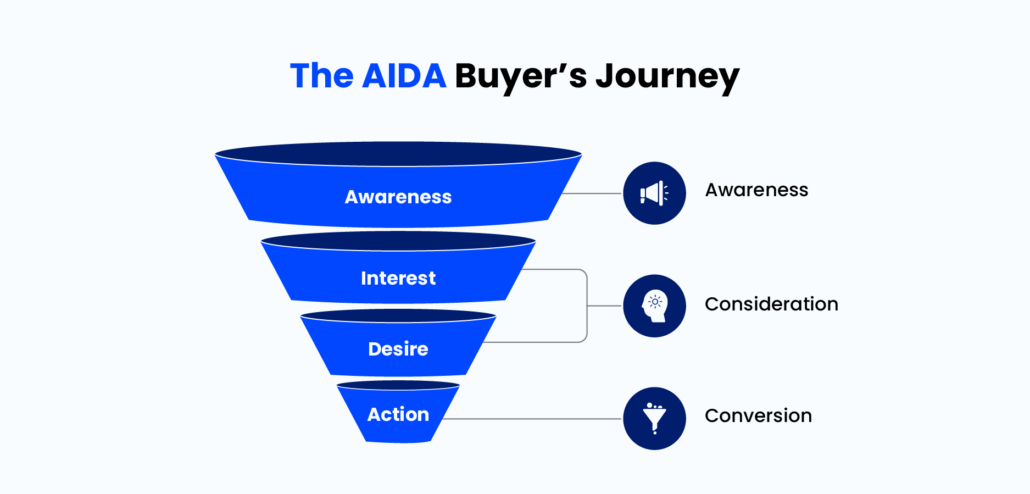
For example, a business can develop awareness campaigns for customers in the early stages, using educational content to introduce them to the brand. For those in the consideration stage, personalized offers and detailed product information can help move them towards a purchase decision. By tailoring marketing efforts to the customer journey stage, businesses can improve customer satisfaction, loyalty, and retention, ensuring a smoother and more effective customer journey.
Engagement level segmentation
Engagement level segmentation categorizes customers based on their level of engagement with a brand or product. This type of behavioral segmentation helps businesses identify highly engaged customers and develop strategies to retain them. Engagement can be measured through social media interactions, email open rates, website traffic, and more.
By segmenting customers based on their engagement levels, businesses can create targeted marketing campaigns to increase engagement and loyalty. For instance, offering personalized content or exclusive deals to highly engaged customers can further strengthen their connection to the brand. Conversely, businesses can design social media campaigns or email outreach to re-engage less active customers. This approach ensures that marketing efforts are tailored to the specific needs and behaviors of different customer segments, driving overall engagement and loyalty.
Real-World Examples of Behavioral Segmentation
Now, let’s discuss some behavioral segmentation examples.
Example 1: E-commerce website personalization
Amazon‘s recommendation engine is a prime example of behavioral segmentation in action.
It uses AI and machine learning to examine past purchases, browsing trends, and consumer behavior to offer tailored product recommendations. The recommendation engine accounts for 35% of their revenue, demonstrating how successful this strategy has been for the business.
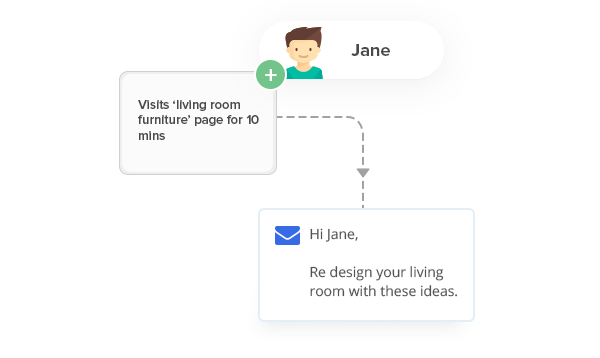
Example 2: Seasonal promotions in retail
Target excels at seasonal marketing by analyzing historical purchase data.
They alter the inventories and marketing mix in terms of regional differences and past buying habits, so that the campaign advertisements are more effective.
Example 3: Customer retention strategy for subscription services
Spotify utilizes user listening behaviors to build more personalized playlists and recommendations. It helps engage users – who would otherwise churn out – by making the delivered playlists more personal.
The “Discover Weekly” feature of Spotify, based on behavior data, creates personal playlists for the users, thereby achieving a higher level of user satisfaction and yielding better retention rates for the subscription services.
Example 4: Travel industry customer journey mapping
Expedia segments customers based on planning behavior, offering different packages to last-minute planners versus those who plan ahead. They break down the search patterns and the booking windows along with destination preferences to provide them with the most suitable recommendations as well as price strategies.
Example 5: Mobile marketing and app usage patterns
Duolingo divides learners into groups according to patterns of learning and engagement levels. Thus, reminder frequencies and lesson difficulties are adapted.
The behavioral approach has worked very well for them as they have a seemingly 50 percent retention rate that is way above the norm.
Example 6: Fitness industry lifestyle benefits
Peloton segments users based on their preferred types of workouts and fitness objectives for presenting tailored content and competitions. These exercise times, intensity preferences, and social interactions are provided to design targeted motivational planning.
Example 7: Food delivery services and customer preferences
DoorDash curates the restaurants and discounts that appear in its app based on order history and timing, for example. It could analyze peak-ordering-times, cuisine preferences, and price sensitivity to optimize marketing.
Example 8: Banking sector loyalty programs
American Express categorizes the customers based on particular spending behavior so that dispersed rewards and services are offered to each customer.
They collect information about the actual transaction and monitor customers’ lifestyle preferences. From this data, they design each customer’s interest-based reward program, which eventually drives loyalty.
Example 9: Entertainment services and engagement strategies
Disney+ examines viewership behavior to recommend content and provides a tailored user interface for various family members. Its algorithm seeks to find the best possible content by accounting for viewing history, hours of the day, and devices used.
Example 10: Automotive industry after-sales behavior
Toyota relies on the service history and the age of its vehicles to target the most relevant maintenance offers and upgrade options for its customers. It examines patterns of driving and service intervals to formulate proactive maintenance recommendations.
Practical Strategies for Leveraging Behavioral Data
Let’s keep it crisp – here are pointers you should follow:
Segmenting your audience effectively
- Begin with clear objectives and goals
- Identify the most important behavioral indicators and metrics
- Create rich customer personas and profiles
- Test and refine segments frequently
- Monitor how segments are doing and evolve over time
Utilizing data analytics tools
- Implement strong tracking systems and platforms
- Leverage AI and machine learning technology for pattern recognition
- Use integration of multiple data sources to build deeper insights
- Monitor real-time behavioral data and trends
- Applying predictive analytics for future behavior
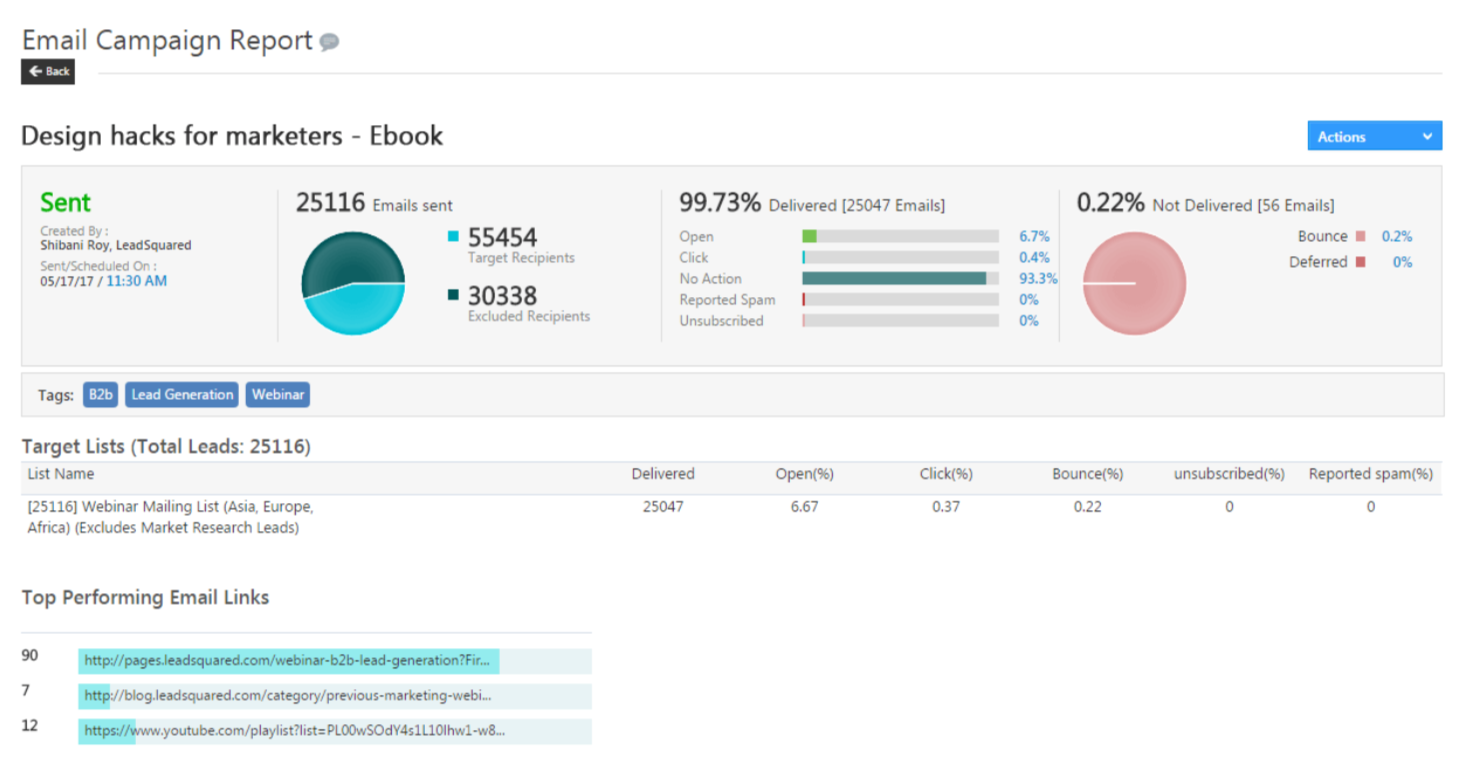
Crafting targeted marketing campaigns
To implement effective behavioral segmentation:
- Develop messaging and content tailored to the segment
- Determine appropriate channels for every segment
- Content development geared to specific behaviors
- Campaign timing will be optimized based on patterns
- Test campaign effectiveness and look for ways to make it better
To give you an example, here’s why you need to do behavioral segmentation for an email campaign:
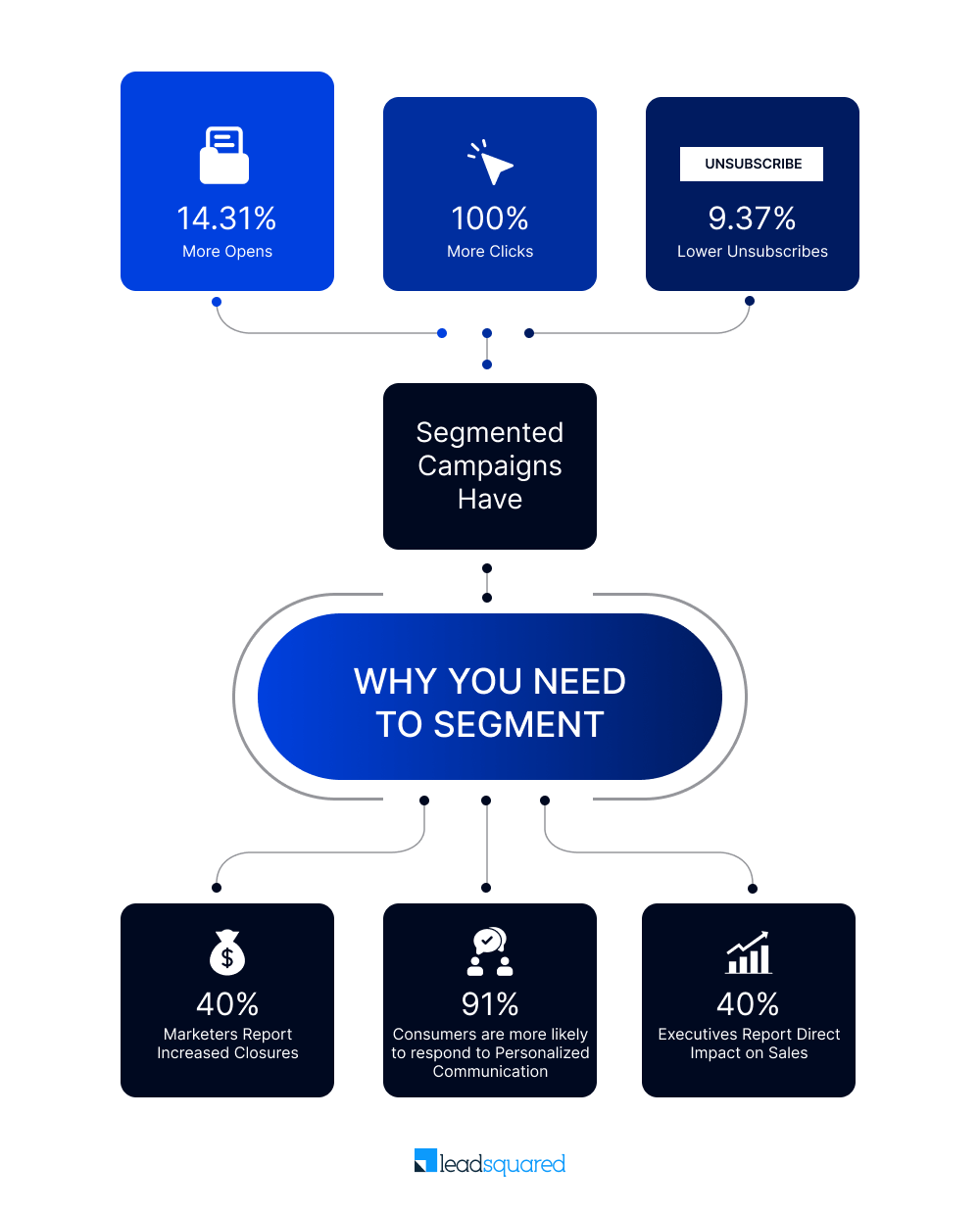
Pro tip: By eliminating a lot of the uncertainty surrounding segmentation, LeadSquared‘s all-inclusive sales and marketing platform enables you to take advantage of additional opportunities. It helps you automate your email marketing, so you never miss an opportunity to create lasting relationships. You can segment your emails using anything from buying triggers to website behavior!
Monitoring customer feedback
You should:
- Collect and analyze customer feedback systematically
- Keep tabs on campaign metrics
- Check the level of customer satisfaction and engagement
- Design strategies based on results and insights
- Establish a continuous process of improvement
Wrapping Up
Behavioral segmentation is one of the most powerful tools used by marketers today.
Across US industries, the benefit of moving to top-quartile performance in personalization is $1 trillion. By understanding and implementing behavioral segmentation examples in your marketing strategy, you can improve customer engagement, increase conversion rates, and build stronger customer relationships.
Remember, it is a continuous process that should be regularly assessed and adapted to be very effective. You can take these examples of behavioral segmentation and shape them to the needs of your business and target customers. As you do this, you will find that you are better equipped to meet the customer’s expectations while attaining your company’s marketing goals within this competitive marketplace.
Furthermore, you can analyze your customers’ behavior. This process can be automated with customized reports using technologies like LeadSquared reporting, and you can act on your results with ease!
Don’t lose out on the advantages of customer behavioral segmentation — they are too great to be overlooked! Book a demo with LeadSquared to see how it can help you in the process.









